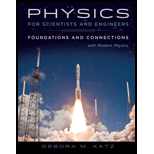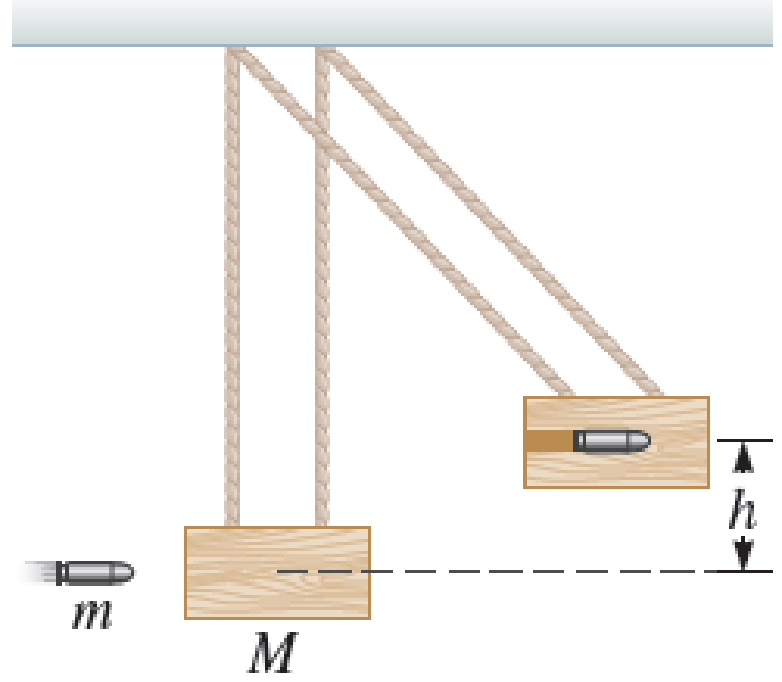
Webassign Printed Access Card For Katz's Physics For Scientists And Engineers: Foundations And Connections, 1st Edition, Single-term
1st Edition
ISBN: 9781337684637
Author: Debora M. Katz
Publisher: Cengage Learning
expand_more
expand_more
format_list_bulleted
Textbook Question
Chapter 11, Problem 33PQ
A bullet of mass m is fired into a ballistic pendulum and embeds itself in the wooden bob of mass M (Fig. P11.33). After the collision, the pendulum reaches a maximum height h above its original position. a. Show that the kinetic energy of the system decreases by the factor m/(m + M) immediately after the collision. b. What is the change in momentum of the bullet-bob system due to the collision?

FIGURE P11.33
Expert Solution & Answer
Trending nowThis is a popular solution!

Students have asked these similar questions
Please don't use Chatgpt will upvote and give handwritten solution
how would i express force in vector form I keep getting a single number
please help me solve this questions. show all calculations and a good graph too :)
Chapter 11 Solutions
Webassign Printed Access Card For Katz's Physics For Scientists And Engineers: Foundations And Connections, 1st Edition, Single-term
Ch. 11.1 - Forensic Science Forensic science is the...Ch. 11.2 - Why does a coach instruct a gymnast to bend her...Ch. 11.3 - When two objects collide, the impulse exerted on...Ch. 11.3 - Prob. 11.4CECh. 11.5 - If a spacecraft is headed for the outer solar...Ch. 11.6 - The cue ball hits the eight-ball in a game of pool...Ch. 11 - When a spacecraft collides with a planet, it is...Ch. 11 - When a person feels that he is about to fall, he...Ch. 11 - A tall man walking at 1.25 m/s accidentally bumps...Ch. 11 - Prob. 4PQ
Ch. 11 - A basketball of mass m = 625 g rolls off the hoops...Ch. 11 - Prob. 6PQCh. 11 - Sven hits a baseball (m = 0.15 kg). He applies an...Ch. 11 - Prob. 8PQCh. 11 - Prob. 9PQCh. 11 - In a laboratory, a cart collides with a wall and...Ch. 11 - Prob. 11PQCh. 11 - A Show that Equation 11.4 (the impulsemomentum...Ch. 11 - A crate of mass M is initially at rest on a level,...Ch. 11 - Prob. 14PQCh. 11 - Two pucks in a laboratory are placed on an air...Ch. 11 - A truck collides with a small, empty parked car....Ch. 11 - Prob. 17PQCh. 11 - Prob. 18PQCh. 11 - A skater of mass m standing on ice throws a stone...Ch. 11 - A skater of mass 45.0 kg standing on ice throws a...Ch. 11 - Prob. 21PQCh. 11 - In a laboratory experiment, 1 a block of mass M is...Ch. 11 - Ezra (m = 25.0 kg) has a tire swing and wants to...Ch. 11 - A suspicious physics student watches a stunt...Ch. 11 - A 2.45-kg ball is shot into a 0.450-kg box that is...Ch. 11 - Prob. 26PQCh. 11 - Prob. 27PQCh. 11 - Prob. 28PQCh. 11 - A dart of mass m is fired at and sticks into a...Ch. 11 - A dart of mass m = 10.0 g is fired at and sticks...Ch. 11 - A bullet of mass m = 8.00 g is fired into and...Ch. 11 - Prob. 32PQCh. 11 - A bullet of mass m is fired into a ballistic...Ch. 11 - Prob. 34PQCh. 11 - One object (m1 = 0.200 kg) is moving to the right...Ch. 11 - Prob. 36PQCh. 11 - Prob. 37PQCh. 11 - Prob. 38PQCh. 11 - Two objects collide head-on (Fig. P11.39). The...Ch. 11 - Initially, ball 1 rests on an incline of height h,...Ch. 11 - Initially, ball 1 rests on an incline of height h,...Ch. 11 - In an attempt to produce exotic new particles, a...Ch. 11 - Pendulum bob 1 has mass m1. It is displaced to...Ch. 11 - Prob. 44PQCh. 11 - Prob. 45PQCh. 11 - Prob. 46PQCh. 11 - Prob. 47PQCh. 11 - Prob. 48PQCh. 11 - Two skateboarders, with masses m1 = 75.0 kg and m2...Ch. 11 - In a laboratory experiment, an electron with a...Ch. 11 - In Figure P11.51, a cue ball is shot toward the...Ch. 11 - A proton with an initial speed of 2.00 108 m/s in...Ch. 11 - A football player of mass 95 kg is running at a...Ch. 11 - Two bumper cars at the county fair are sliding...Ch. 11 - Two bumper cars at the county fair are sliding...Ch. 11 - Prob. 56PQCh. 11 - N A bomb explodes into three pieces A, B, and C of...Ch. 11 - Prob. 58PQCh. 11 - An object of mass m = 4.00 kg that is moving with...Ch. 11 - A wooden block of mass M is initially at rest at...Ch. 11 - Prob. 61PQCh. 11 - Prob. 62PQCh. 11 - In an experiment designed to determine the...Ch. 11 - From what might be a possible scene in the comic...Ch. 11 - Prob. 65PQCh. 11 - Two pucks in a laboratory are placed on an air...Ch. 11 - Assume the pucks in Figure P11.66 stick together...Ch. 11 - Prob. 68PQCh. 11 - Prob. 69PQCh. 11 - A ball of mass 50.0 g is dropped from a height of...Ch. 11 - Prob. 71PQCh. 11 - A pendulum consists of a wooden bob of mass M...Ch. 11 - Three runaway train cars are moving on a...Ch. 11 - Prob. 74PQCh. 11 - Rutherford fired a beam of alpha particles (helium...Ch. 11 - Prob. 76PQCh. 11 - Prob. 77PQCh. 11 - February 3, 2009, was a very snowy day along...Ch. 11 - A cart filled with sand rolls at a speed of 1.0...Ch. 11 - Prob. 80PQCh. 11 - Prob. 81PQCh. 11 - Prob. 82PQCh. 11 - Prob. 83PQCh. 11 - Prob. 84PQ
Knowledge Booster
Learn more about
Need a deep-dive on the concept behind this application? Look no further. Learn more about this topic, physics and related others by exploring similar questions and additional content below.Similar questions
- What is the force (in N) on the 2.0 μC charge placed at the center of the square shown below? (Express your answer in vector form.) 5.0 με 4.0 με 2.0 με + 1.0 m 1.0 m -40 με 2.0 μCarrow_forwardWhat is the force (in N) on the 5.4 µC charge shown below? (Express your answer in vector form.) −3.1 µC5.4 µC9.2 µC6.4 µCarrow_forwardAn ideal gas in a sealed container starts out at a pressure of 8900 N/m2 and a volume of 5.7 m3. If the gas expands to a volume of 6.3 m3 while the pressure is held constant (still at 8900 N/m2), how much work is done by the gas? Give your answer as the number of Joules.arrow_forward
- The outside temperature is 25 °C. A heat engine operates in the environment (Tc = 25 °C) at 50% efficiency. How hot does it need to get the high temperature up to in Celsius?arrow_forwardGas is compressed in a cylinder creating 31 Joules of work on the gas during the isothermal process. How much heat flows from the gas into the cylinder in Joules?arrow_forwardThe heat engine gives 1100 Joules of energy of high temperature from the burning gasoline by exhausting 750 Joules to low-temperature . What is the efficiency of this heat engine in a percentage?arrow_forward
- L₁ D₁ L₂ D2 Aluminum has a resistivity of p = 2.65 × 10 8 2. m. An aluminum wire is L = 2.00 m long and has a circular cross section that is not constant. The diameter of the wire is D₁ = 0.17 mm for a length of L₁ = 0.500 m and a diameter of D2 = 0.24 mm for the rest of the length. a) What is the resistance of this wire? R = Hint A potential difference of AV = 1.40 V is applied across the wire. b) What is the magnitude of the current density in the thin part of the wire? Hint J1 = c) What is the magnitude of the current density in the thick part of the wire? J₂ = d) What is the magnitude of the electric field in the thin part of the wire? E1 = Hint e) What is the magnitude of the electric field in the thick part of the wire? E2 =arrow_forwardplease helparrow_forwardA cheetah spots a gazelle in the distance and begins to sprint from rest, accelerating uniformly at a rate of 8.00 m/s^2 for 5 seconds. After 5 seconds, the cheetah sees that the gazelle has escaped to safety, so it begins to decelerate uniformly at 6.00 m/s^2 until it comes to a stop.arrow_forward
- A projectile is fired with an initial speed of 40.2 m/s at an angle of 35.0 degree above the horizontal on a long flat firing range. Determine. please help and show work for them so i can understand.arrow_forwardpls helparrow_forwardJ K L The graph in the figure shows the position of an object as a function of time. The letters H-L represent particular moments of time. At which moments shown (H, I, etc.) is the speed of the object the greatest? + Position H I K Timearrow_forward
arrow_back_ios
SEE MORE QUESTIONS
arrow_forward_ios
Recommended textbooks for you
 Physics for Scientists and Engineers: Foundations...PhysicsISBN:9781133939146Author:Katz, Debora M.Publisher:Cengage Learning
Physics for Scientists and Engineers: Foundations...PhysicsISBN:9781133939146Author:Katz, Debora M.Publisher:Cengage Learning University Physics Volume 1PhysicsISBN:9781938168277Author:William Moebs, Samuel J. Ling, Jeff SannyPublisher:OpenStax - Rice University
University Physics Volume 1PhysicsISBN:9781938168277Author:William Moebs, Samuel J. Ling, Jeff SannyPublisher:OpenStax - Rice University Principles of Physics: A Calculus-Based TextPhysicsISBN:9781133104261Author:Raymond A. Serway, John W. JewettPublisher:Cengage Learning
Principles of Physics: A Calculus-Based TextPhysicsISBN:9781133104261Author:Raymond A. Serway, John W. JewettPublisher:Cengage Learning Physics for Scientists and Engineers with Modern ...PhysicsISBN:9781337553292Author:Raymond A. Serway, John W. JewettPublisher:Cengage Learning
Physics for Scientists and Engineers with Modern ...PhysicsISBN:9781337553292Author:Raymond A. Serway, John W. JewettPublisher:Cengage Learning Physics for Scientists and EngineersPhysicsISBN:9781337553278Author:Raymond A. Serway, John W. JewettPublisher:Cengage Learning
Physics for Scientists and EngineersPhysicsISBN:9781337553278Author:Raymond A. Serway, John W. JewettPublisher:Cengage Learning Glencoe Physics: Principles and Problems, Student...PhysicsISBN:9780078807213Author:Paul W. ZitzewitzPublisher:Glencoe/McGraw-Hill
Glencoe Physics: Principles and Problems, Student...PhysicsISBN:9780078807213Author:Paul W. ZitzewitzPublisher:Glencoe/McGraw-Hill

Physics for Scientists and Engineers: Foundations...
Physics
ISBN:9781133939146
Author:Katz, Debora M.
Publisher:Cengage Learning

University Physics Volume 1
Physics
ISBN:9781938168277
Author:William Moebs, Samuel J. Ling, Jeff Sanny
Publisher:OpenStax - Rice University

Principles of Physics: A Calculus-Based Text
Physics
ISBN:9781133104261
Author:Raymond A. Serway, John W. Jewett
Publisher:Cengage Learning

Physics for Scientists and Engineers with Modern ...
Physics
ISBN:9781337553292
Author:Raymond A. Serway, John W. Jewett
Publisher:Cengage Learning

Physics for Scientists and Engineers
Physics
ISBN:9781337553278
Author:Raymond A. Serway, John W. Jewett
Publisher:Cengage Learning

Glencoe Physics: Principles and Problems, Student...
Physics
ISBN:9780078807213
Author:Paul W. Zitzewitz
Publisher:Glencoe/McGraw-Hill
Impulse Derivation and Demonstration; Author: Flipping Physics;https://www.youtube.com/watch?v=9rwkTnTOB0s;License: Standard YouTube License, CC-BY